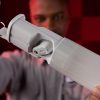What a long, strange trip it’s been.
Without getting into a near-theological discussion about the relative merits of analog vs. digital audio (especially popular these days among aficionados of vinyl), that single shift — of analog to digital — has triggered a massive change in music consumption (to say nothing of similar transformations in music production, music licensing, music distribution, music marketing, etc.). It should go without saying; in the absence of digital, there is no iTunes, no Spotify, no Slacker.
I just want to start with a disclaimer: I’m not an audiophile, musician, or audio hobbyist. So while I’ve been in the industry since the early ‘80s, I may not be in the best position to offer nostalgia about the audio industry’s past. Having said that, we live in an era where the ability to reproduce sound accurately has never been greater – and the platforms from which to experience it have never been better (more diverse, more accurate, more accessible, more ubiquitous).
The industry, the consumer, has moved beyond audio-only. Not at the expense of audio, but at the enhancement of the experience of audio. Today’s component system simply consists of more parts than it did a generation ago, even as some of the building blocks of yesterday’s systems have ceased being discrete elements. Systems now address eyes as well as ears.
Consider the options. Today, you can use a pre-packaged, home-theater-in-a-box system for your audio components, which does not include your TV or your media source component (DVD/Blu-ray, etc.). Typically these systems are easy to set up since the components are designed to work together. However, if you want a high-quality, full surround sound experience, it is still better to build your own system… assuming, of course, that you feel comfortable choosing and setting up your own components. In a very real way, yesterday’s component stereo system has morphed into today’s home theater system:
- TV. You need a big picture, which can mean something different to you depending on your room size, but typically 32” screen at minimum is best. For an updated home theater system you need a flat screen, high-definition television.
- Digital Media Player. This could be one or more of the following components that plays stored media: DVD/Blu-Ray player, DVR, iPod, Playstation/Xbox, etc.
- Receiver. Simply put, this is an essential, core element to any home theater system to amplify audio/video signals from the source and route them to your TV.
- Speakers. Speakers are crucial to getting a quality audio experience. Typical set-ups involve at least 4-5 speakers or possibly more depending on your room size and what you need to bring rich, theater sound into your home.
- Subwoofer. The sub is what delivers deep and powerful bass, the low frequency sound that brings movies with special effects to life right in your living room. Depending on your room size and set up, more than one subwoofer may be used to complete your system.
- Accessories, odds and ends. This means A/V cables, speaker wires, surge protectors, and a universal remote to control your whole system.
There was a certain amount of snake oil sold alongside stereo components, and I’ve never been comfortable with that fact. I think the Internet is mostly responsible for popping this bubble, offering information now, for free, which used to be the property of the stereo store proprietor.
Over the years, the audio industry has shifted its emphasis to custom installation. As a player in this market, we’ve been sensitive about developing components (in our case, subwoofers) that deliver superior sound in every type of system. Starting with the introduction of the world’s first remote-controlled subwoofers, we’ve engineered sophisticated and easy-to-use digital room bass EQ systems; easy to build in-wall, in-cabinet, in-floor and in-room subwoofers; and one button to perfect bass automatic equalizations for music, theater and games. The point is, it’s vital that manufacturers listen to their customers and reach them where they are.
The love of music will go on forever, and there is a lot of opportunity to design new hardware to reproduce it today that couldn’t have been built in the past.
In our 30+ years in the business, this much has not changed: an important population expects and demands high-quality sound. What’s different is that it’s now an always-on world. Those who love music are not confined to living rooms decked out with components housed in cabinets and bolted to walls. Consumers want high-quality sound wherever they go. With the ubiquity of iPods and smartphones in recent years, everyone from kids to teens to adults of all ages has been literally embracing headphones for portable audio. Trends have certainly developed as headphones have become a fashion accessory (again, appealing to the eye as well as to ear). Listeners have become much more conscious of the color, shape and size of the headphones that they are wearing in addition to (and, frankly, sometimes in place of!) the sound quality.
Perfection may be elusive, but the pursuit of it isn’t – and that is what continues to animate this business.
by David Hall, founder and CEO, Velodyne Acoustics
About the Author:
David Hall is the technology visionary behind Velodyne Acoustics, Inc. He built his first amplifier at the age of four and has been developing groundbreaking products ever since. In 1983, he introduced a revolutionary technology in subwoofer design, which served as the driving force behind the ULD-18. It incorporated a patented, accelerometer-based High Gain Servo System to control woofer cone movement. The ULD series was the first of many acclaimed subwoofer series over the past 30 years. Hall is equally comfortable writing computer code as he is at working in a machine shop.






























